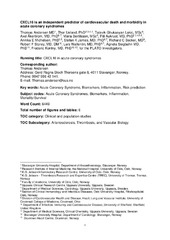C-X-C ligand 16 is an independent predictor of cardiovascular death and morbidity in acute coronary syndromes
Permanent lenke
https://hdl.handle.net/10037/17539Dato
2019-09-26Type
Journal articleTidsskriftartikkel
Peer reviewed
Forfatter
Andersen, Thomas; Ueland, Thor; Ghukasyan Lakic, Tatevik; Åkerblom, Axel; Bertilsson, Maria; Aukrust, Pål; Michelsen, Annika E; James, Stefan K.; Becker, Richard C.; Storey, Robert F.; Wallentin, Lars; Siegbahn, Agneta; Kontny, FredericSammendrag
Approach and Results: - Serial measurements of CXCL16 were performed in a subgroup of 5142 patients randomized in the PLATO trial (Platelet Inhibition and Patient Outcome). Associations between CXCL16 and a composite of cardiovascular death, spontaneous myocardial infarction or stroke, and the individual components were assessed by multivariable Cox regression analyses. The hazard ratio per 50% increase in admission levels of CXCL16 analyzed as continuous variable was 1.64 (95% CI, 1.44–1.88), P<0.0001. This association remained statistically significant after adjustment for randomized treatment, clinical variables, CRP (C-reactive protein), leukocytes, cystatin C, NT-proBNP (N-terminal pro-brain natriuretic peptide), troponin T, GDF-15 (growth differentiation factor 15), and other biomarkers; hazard ratio 1.23 (1.05–1.45), P=0.0126. The admission level of CXCL16 was independently associated with cardiovascular death (1.50 [1.17–1.92], P=0.0014) but not with ischemic events alone, in fully adjusted analyses. No statistically independent association was found between CXCL16 measured at 1 month, or change in CXCL16 from admission to 1 month, and clinical outcomes.
Conclusions: - In patients with acute coronary syndrome, admission level of CXCL16 is independently related to adverse clinical outcomes, mainly driven by an association to cardiovascular death. Thus, CXCL16 measurement may enhance risk stratification in patients with this condition.


 English
English norsk
norsk